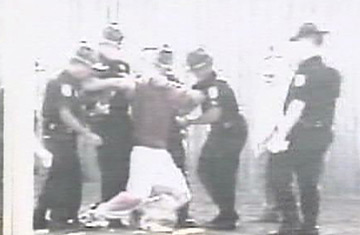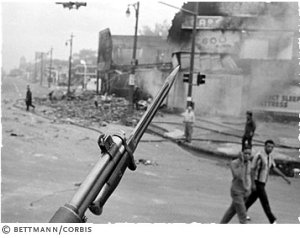The Border Wall
I don’t feel particularly bad about the fact that Ephraim Cruz lost his job with the Border Patrol. The Border Patrol should not exist at all, and the men and women who decide to join it are, whether they realize it or not, violently inflicting injustices on innocent people every day, as an essential part of their job duties. Cruz seems to me like a basically decent man with an acute conscience, and it will be better for him now that he has to find an honest line of work.
But Jenn’s interview with Cruz at reappropriate is still powerful, and important to read, because of what it tells us about the institutional culture of policing in general, and border policing in particular. It should be no surprise that the Blue Wall stays in place when the uniforms change from blue to green; if anything, it is worse, because abusive border cops can rely on getting away with even more than abusive ordinary cops can. Their usual victims have no formal standing as citizens, often cannot speak English well, have few advocates with high profiles in the media or the legal system, and are about to be forced out of the country, far away from anyone who might do anything about their mistreatment.
Ephraim Cruz, a former patrol agent with the U.S. Border Patrol, tried to do something about Border Patrol agents who abused captured and imprisoned immigrants. Here are some of the things that he saw while he was stationed in Arizona:
Ephraim was also amazed to find cells were frequently filled to two or three times their posted capacity, while neighbouring cells were not being utilized at all. Not only was this a clear violation of fire codes, but Ephraim feared this practice could pose a serious health risk for detainees.
… But, most heart-wrenching for Ephraim was the observation that detainees were frequently going twenty to thirty hours at a time without food. In his March 21, 2004 memo, Ephraim recounts how he watched a young ten-year-old boy — whom his mother described as in good health — break out into red bumps after going more than twenty hours without a meal. Later that same day, Ephraim remembers how a young girl went more than thirty hours without food, and complained of feeling faint. These were hardly isolated incidents: Ephraim remembers countless children and pregnant women who went without food for two or three shifts at a time.
According to Border Patrol spokesperson Andy Adame (quoted in archived Tucson Citizen article Border Agent Claims Detainees Mistreated in Douglas, written by Luke Turf, published May 22, 2004), Border Patrol policies state that all detainees should be
fed at 6am, noon and 6pm and ... crackers and juice are always available for immigrants. However, Ephraim writes in an August 5, 2004 memo (Memo from E. Cruz to R. Bonner, SUBJECT: Ongoing Mistreatment of Illegal Aliens and Processing Issues):The integrity of those meal times are habitually violated, and crackers and juice are not always available. Furthermore, when crackers and juice are indeed available, it is not readily provided to the detainees... It is station policy that we feed all illegal aliens held beyond six to eight hours. Many illegal aliens easily go two to three times beyond that time frame without one meal.
In that same memo, Ephraim recounts how on July 31, 2004, he approached the control room that 220 meals would be needed that day, only to be told that 70 meals would be ordered. Most likely, Ephraim opined, two-thirds of detainees at the facility went hungry that day. According to Ephraim, the Douglas station also went weeks at a time without replenishing their supply of juice and crackers, and even when such items were in stock, they were not always made available to detainees. In one incident, Ephraim left some juice and crackers near the door of a holding cell only to have a fellow Agent remove the food moments later, muttering to Ephraim that by leaving it within reach of detainees, they might assume the food was for them.
Ephraim further notes that there was a distinct lack of concern for detainees amongst Agents; an almost dehumanization of the UDAs [Undocumented Aliens –R.G.] that helped perpetuate the mistreatment. Ironically, the Agents — who were predominantly Mexican American —
looked down on UDAsas if to say that they, as legal Mexican Americans, were better than the Mexican detainees. Many seemed to feel that detainees deserved their mistreatment; Ephraim recalls how in one instance, while denying food to a detainee, one agent remarked that[the illegal aliens] knew they were coming, they should have brought food with them.The dehumanization extended in one case to abuse reminiscent of the Abu Ghraib scandal (which ironically occurred only a few months after Ephraim began writing his memos). On March 1, 2005, Ephraim wrote a memo that included a recount of an incident he observed(Memo from E. Cruz to M. Nicely, Chief Patrol Agent, Tucson Sector) :
[I] informed FOS Jeffrey Richards and FOS Ignacio Luevano, in the presence of SBPA Robert Marrufo that SBPFA Marrufo directed BPA Jon Gleber to put an undocumented alien in our custody in a stress position. The incident took place about two weeks ago on the north side of the processing floor and to the knowledge of other agents. The stress position consisted of the alien performing the chair which entails leaning against the wall with both legs at a 90 degree angle and both hands straight out. They had the alien remain in that position until he buckled and cried.
Marrufo then suggested that the alien be placed in the forward leaning rest position, a push-up position, to give him some exercise, however I don't know if Agent Gelber followed through with the suggestion.
In 2004, Cruz, believing that a man's conscience is God's voice,
began to write memos and letters to try to make his supervisors, politicians, and the media aware of violations of policies, training, state laws, fire and health codes, and illegal aliens' civil and human rights within [the Douglas, Arizona] processing facility.
Here is what happened:
Ephraim writes in his March 21, 2004 memo (Memo from E. Cruz to supervisors, 2004):
This culture... reflects a disturbing level of complacency and lack of accountability and is coupled with responses... that this is the way things are done.
Ephraim describes this culture of complacency as fostering the sentiment that,
management condoned [the mistreatment] and Agents knew that management knew and [were] not correcting it.Therefore, Ephraim says, Agents asked themselveswhy should I rock the boat?… Despite his 117 letters, Ephraim received little support from the Senators and Congressmen he contacted. Andy Adame, Border Patrol spokesperson, told the media that the Office of the Inspector General (OIG) would conduct a generic investigation of Ephraim's accusations, but a recent article by the Tucson Weekly reports that this investigation — though supposedly having found Ephraim's claims to be unsubstantiated — may never have actually taken place.
After he began speaking out, Cruz found that his employee review scores suddenly plummeted. One supervisor encouraged his co-workers to take care of him
for the accusations. Then, in 2005, he was brought up on federal charges for transporting an illegal alien across the border.
He and some friends had gone across the border into Agua Prieta after work, and on his way back he gave Maria Terrazas — a waitress who lived in Douglas and who was dating one of his colleagues at the Border Patrol — a ride back across the border to her home in Douglas. Later, in an unrelated criminal investigation against her boyfriend, it turned up that she didn’t have her papers. Cruz, who had no way of knowing this at the time, was brought up on federal charges. Nobody else involved in giving Terrazas the ride was charged. If he had been convicted, Cruz could have been sentenced to up to 20 years in a federal prison for this non-crime. As it turns out, the jury found the prosecution baseless and acquitted him on all charges. But that didn’t stop the retaliation. Last month, he received a letter from the U.S. Border Patrol stating that he would be fired on administrative charges — the same charges that a federal jury had already acquitted him of. He has been forced to resign so that he could avoid having this baseless smear go on his record; he could not afford a lawyer to fight the dismissal in court.
When it comes to cases of corruption or abuse, it’s often said that cops will protect their own.
That’s close to the truth, but it misses the mark in one important respect. Cops — and this manifestly includes border cops, too — will try as hard as they can to intimidate, harass, defame, abandon, hurt, fire, imprison, or even kill any of their own who speak out against their colleagues’ crimes.
That isn’t cops protecting their own.
It’s cops protecting their power. And they’ll do just about anything to absolutely anybody who endangers it. Ephraim Cruz is the latest of many victims to get the long knife treatment.


